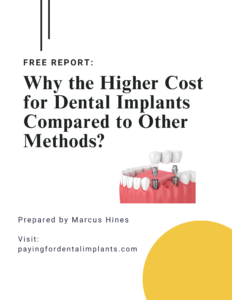Physical Address
12245 Cypress Spring Road, Clarksburg, MD 20871
Physical Address
12245 Cypress Spring Road, Clarksburg, MD 20871

When planning for costly healthcare procedures like dental implants, a Health Savings Account (HSA) can be a game-changer and make your implant procedure affordable.
Last updated on May 16th, 2025 at 08:09 am
When planning for costly healthcare procedures like dental implants, a Health Savings Account (HSA) can be a game-changer. An HSA can be used for dental implants to make your treatment affordable. Understanding how to manage the process effectively is key. Unfortunately, many people are unsure how an HSA works so I decided to write this post. Not to fear. In plain language we’ll give focus to how an HSA works, discuss its benefits, requirements, and how to use an HSA to make your dental implant treatment affordable.
In very simple terms, an HSA is like a special savings account that is designated for healthcare expenses. You can contribute money to it and then use those funds to pay for qualified medical and dental expenses—including dental implants.
One benefit patients appreciate most about an HSA plan is that any funds contributed are tax-free. This means your, for instance, your HSA funds used for the purposes of dental implant treatment are not taxed by “Uncle Sam!”
And in 2025, you can contribute even more funds to an HSA than was allowed in 2024. More on 2025 contribution amounts shortly. For now, think of an HSA as a win-win for at least three reasons:
In order to establish an HSA you must first be covered by a HSA-qualified health plan. “What does this mean?” HSA-qualified health plans are usually High-Deductible Health Plans (HDHP). If you are enrolled in a HDHP, to serve as your medical insurance, you can open an HSA.
For year 2025, the minimum health insurance deductible is set at $1,650 for individuals or $3,300 for families in order to be eligible to contribute to an HSA. If you anticipate, in the near future, needing a costly medical procedure(s) that will require a deductible before your medical insurance kick’s in, an HSA may not be the best choice for you. Speak with your HR and financial advisor first.
If you are enrolled in either a traditional medical health insurance, Medicare or Medicaid program, you are not eligible to enroll in an HSA. To qualify for an HSA you:
Note: An HDHP means you pay more out-of-pocket costs before your medical insurance will provide coverage for your treatment. The trade-off is lower monthly premiums with an HDHP and the ability contribute to an HSA savings plan.
The great news is that your HSA contributions can be made by you, your employer, or both. The contribution limit for 2025 is $4,300 for individuals and $8,550 for families. And, if you are age 55 or older, an extra $1,000 can be contributed each year. How cool is that?!
Unused HSA funds roll over each year. Therefore, you’re not pressured to spend the funds before an annual deadline. This is one major benefit that I appreciate of an HSA over an FSA.
If you maximize your family contributions over a two year period, you will accumulate a total of $17,100 ($8,550 x 2 years) or $25,650 in three years. This approach is sure to make your dental implants affordable.
Note: If you so choose, your unspent HSA funds can be invested and grow tax-free—similar to a retirement account but for healthcare.
Here’s how an HSA paired with a High-Deductible Health Plan (HDHP) compares to traditional insurance:
| Feature | HSA + HDHP | Traditional Insurance |
| Monthly premiums | Typically lower | Typically higher |
| Out-of-pocket costs | Higher (but offset by HSA funds) | Lower |
| Tax benefits | Triple tax advantage (contribution, growth, withdrawals) | Limited or none |
| Flexibility | Funds can grow indefinitely | Use-it-or-lose-it with FSAs |
Many people can benefit from establishing an HSA. An HSA is ideal for people who:
I shared Karen’s HSA story in a previous post. The total cost of Karen’s implant procedure was $49,000. Leveraging an HSA for $20,000 of the total cost helped to make her dental implants affordable.
Once Karen understood the benefits of full arch implant dentistry compared with the drawbacks of removable dentures, choosing dental implants to replace her missing and diseased teeth became her only acceptable choice.
When it comes to the cost of dental implants, this can be a significant expense. A full mouth dental implant procedure can cost $25,000 to replace an entire set of teeth for either an upper or lower jaw. But an HSA can make this procedure more affordable. Here’s how:
An HSA is a smart way to save money and prepare for healthcare costs, especially for treatments like dental implants. If you’re covered by an HSA-qualified health plan, take advantage of this opportunity to maximize your savings and make your needed dental implant treatment affordable. If you’re unsure whether your plan qualifies or how to get started, talk to your HR department, insurance provider, or financial advisor. The sooner you start, the more you’ll save—and that’s something to smile about!

This will close in 0 seconds
This will close in 0 seconds